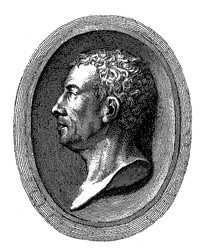Der Kupferstich von Melchior Haffner zeigt, eingefasst in einer ovalen Inschriftenumrahmung, den Büstenausschnitt eines Mannes mit Vollbart in Vorderansicht. Er ist bekleidet mit einem Talar mit breitem weißen Kragen. Das Porträt stellt den deutschen lutheranischen Theologen Johannes Himmel(ius), Professor an der Universität Jena, dar. Der Stich wurde ursprünglich angefertigt für die Publikation von Gottlieb Spitzel, Templum honoris reseratum, Augsburg 1673.
Bez.: JOHANNES HIMMELIUS SS. THEOL. D.ET IN
ACADEM. IENENSI PROF. PUBLICUS. NATUS ANNO 1582
(Johannes Himmel, Protestantler )
u.l.: Melchior Haffner
u.r.: sculpsit Aug.
Schenkung Prof. Maria Fancelli, Florenz 2022 an die Winckelmann-Gesellschaft.
en

